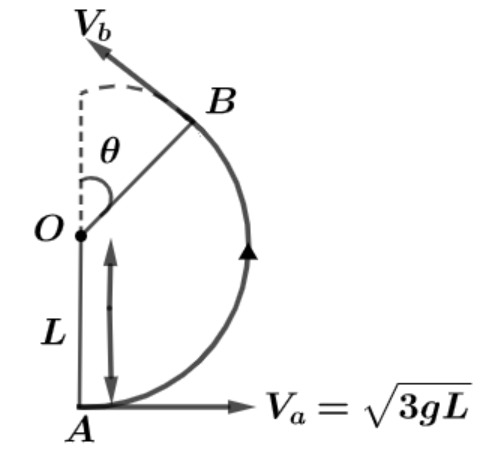Question
Question: A bob is projected with speed of \[\sqrt {3gL} \] from the bottommost point of vertical circular mot...
A bob is projected with speed of 3gL from the bottommost point of vertical circular motion. Find angle ′θ′ with vertical at which bob leaves circular motion. If ′L′ is the length of the string.
Solution
In vertical circular motion, object tends to complete a circular motion in vertical plane, we will use the concept of Law of conservation of energy which can be stated as change in kinetic energy from point A to point B is equals to the gravitational potential energy if object is raised to some height.
Complete step by step answer:
Let us suppose bob is projected at point A with a velocity of 3gL and when it reaches the point B let its velocity be Vb and at point B bob leaves the circular motion when it makes an angle of θ with the vertical axes as shown in the diagram.

Total height from point A to point B can be written as L+Lcosθ
Gravitational potential energy up to this point is −mg(L+Lcosθ)
Kinetic energy of bob at point A can be written as 21mVa2
K.EA=21m(3gL)
Kinetic energy at point B can be written as 21mVb2
K.EB=21mvb2
Now, from law of conservation of energy, the difference of kinetic energy between points from B to point A is equals to the gravitational potential energy, so we can write as
21mvb2−21m(3gL)=−mg(L+Lcosθ)
Or
vb2−(3gL)=−2Lg(1+cosθ)
Or
vb2=Lg(1−2cosθ)→(1)
Now, since at point B just when bob leaves circular motion and balanced by force of gravity which can be written as:
Lmvb2=mgcosθ
Or
vb2=Lgcosθ→(2)
So from equation (1)and(2) we get,
gL−2glcosθ=gLcosθ
Or
cosθ=31
Or
θ=cos−1(31)
Hence, the angle with the vertical made by bob is θ=cos−1(31) .
Note: It should be remembered that, force acting on a body while moving in circular motion is called centripetal force and its magnitude is governed by the formula Fc=rmv2 which acts towards the centre of the circular path and in circular motion the direction of the velocity of a body at any point on the circular path is towards the direction of tangent at that point.
